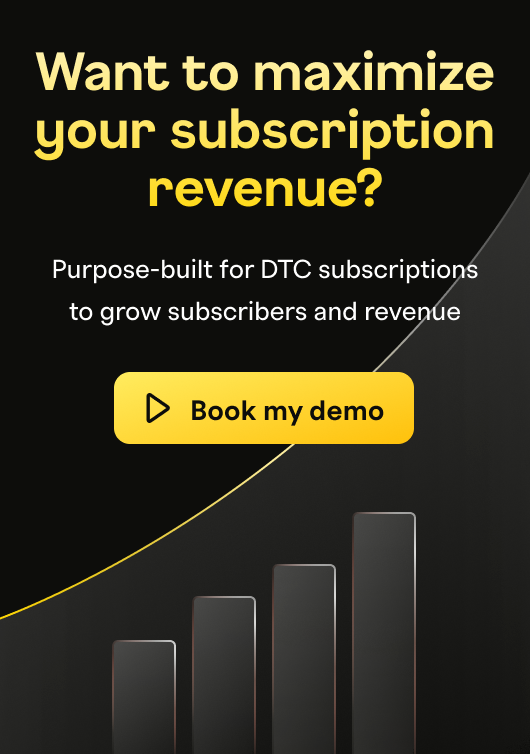Guide to ecommerce subscription management

The global subscription e-commerce market is expected to hit around USD 784.4 billion by 2032, growing at a compound annual growth rate (CAGR) of 25.5% from 2023 to 2032. The average US adult spends $1,080/year on subscriptions. This growth is indicative of a massive shift in consumer behavior where people favor flexibility, recurring access, predictable delivery, and products tailored to their needs.
For ecommerce businesses, subscriptions convert one-time transactions into repeat orders which leads to stronger retention, higher revenue per customer, and more reliable sales patterns.
This guide explains how ecommerce businesses can launch subscriptions, manage billing, reduce churn, and use customer data to adjust plans and pricing.
What is ecommerce subscription management?
Ecommerce subscription management is the process of selling products or services on a recurring basis through an online store. It includes sign-up, billing, shipping, plan changes, renewals, payment updates, customer notifications, and recovery of failed transactions.
The processes include:
Customer sign-up: Collect subscription type, billing details, and contact information with minimal friction. Include fraud screening and mixed cart options for one-time purchases. Delay in any of these steps can lead to abandonment.
Billing: Charge on a fixed or usage-based schedule, while ensuring all taxation requirements are met. Charge on a fixed or usage-based schedule, while ensuring all taxation requirements are met across multiple jurisdictions. Companies may use intelligent retries and account updater services to reduce failed payments during this process.
Shipping and fulfillment: Coordinate inventory and delivery with billing cycles. Late shipments trigger cancellations and support requests.
Customer communication: Send billing confirmations, renewal reminders, and shipping updates. Use messaging to reduce surprises and preempt churn.
Renewals and retention: Automate renewals and allow customers to pause or modify their own plans. Teams can use machine learning to identify churn risk and trigger targeted win-back workflows. AI-powered tools can also deliver proactive insights, helping teams act on growth opportunities before a customer churns.
Fraud prevention: Screen transactions during sign-up and ongoing billing to protect against fraudulent activity while minimizing false positives that could block legitimate customers.
Tax compliance: Automatically calculate and collect appropriate taxes across multiple jurisdictions, handling complex requirements like VAT, GST, and local tax rates. Integrate with revenue recognition systems to ensure compliance with accounting standards.
Revenue expansion: Present upsell and cross-sell opportunities at optimal moments, such as after successful deliveries or during renewal cycles. Enable mixed cart purchases that combine subscriptions with one-time products.
Types of ecommerce subscription models
Ecommerce subscription models determine how customers receive and pay for products or services over time.
Replenishment
Customers receive essential or consumable products, such as razors, coffee, or pet supplies, on a regular schedule.
Access / Membership
Subscribers are granted exclusive benefits such as discounts, premium content, early access to new products, or free shipping.
Curated box
A themed selection of products chosen by the merchant and tailored to customer preferences, often used in beauty, apparel, or hobby verticals.
Subscription box
A recurring delivery of the same product or featured item. Common in niches like books, snacks, or wellness products.
Build-your-own / Personalized
Customers choose certain items or services to get a customized recurring delivery.
Best practices for effective subscription management in ecommerce
The absence of best practices leads to mismanagement of billing, renewals, and any customer changes, leading to failed payments, unshipped orders, and a loss of subscribers and customers. To avoid such outcomes, consider the following:
Seamless customer onboarding and sign-up processes
A slow or confusing sign-up flow includes too many steps, unclear pricing, limited plan options, or unexpected account creation requirements, leading to abandoned carts and lost subscribers. Setup must be as simple as choosing a plan, selecting preferences, entering payment details, and being done in as few clicks as possible. Allowing customers to add both subscription and one-time purchases to the same carthelps reduce onboarding friction and matches how people actually want to shop.
Letting customers adjust delivery frequency or product choices gives them more control, which keeps cancellations and support requests at a minimum. Supporting a variety of popularly used payment methods, including payment services, cards, and digital wallets, to drive up conversion.
Recurring billing and payment management
Businesses need to support monthly, quarterly, or usage-based billing, with automated tax calculations based on subscriber location. With around 12,000 taxing jurisdictions in the U.S., plus global VAT/GST requirements, automated plan management and integrated tax engines help with compliance without manual oversight.
When a payment fails, the system should automatically retry the charge, request an update for any expired cards, and notify the customer with clear messages on their order status. Also, all transactions must be processed securely to protect customer data, meet compliance standards, and avoid fraud.
Efficient order fulfillment and shipping strategies for subscriptions
Each order should be generated after billing and only when inventory is available. If fulfillment runs ahead of processing, or stock isn’t ready, then customers get delays, shipments get missed, and there might even be duplicate charges.
Inventory must be ordered, stored, and allocated based on what’s scheduled to ship and when. Without tracking, businesses risk running out of stock, missing shipments, and leaving products unused.
To keep shipping costs down, businesses can use automated labels, negotiated carrier rates, and set zone-based delivery rules to choose the most efficient shipping method for each order.
Streamlined subscription modifications and upgrades
Subscribers should be able to skip a delivery, pause service, cancel, or switch plans without contacting support. When that control is missing, churn increases and support costs go up.
Upgrade and add-on options work best when they're simple to accept. In-app prompts during renewals or after a successful delivery can increase order value without offering discounts. Tools like Recurly Engage make this possible by letting customers manage their own subscriptions while presenting upgrade opportunities at the right moments.
Proactive customer communication and relationship building
Customers need to know when they'll be charged, when an order is shipping, and if/when something is changing in their plan. Missed or unclear messages are the gateway to failed payments, complaints, and cancellations. With constantly shifting regulations around subscription mandates, card authentication, and regional compliance, what you don’t know about these changing requirements could be costing you customers and revenue.
Messaging should be automated throughout the entire customer journey, from shipping notifications to payment alerts to renewal reminders. These messages should be based on the customer's activity and delivered according to their preferred timing, medium, and messaging style.
Also, feedback should be collected throughout the customer journey, such as after the first order, after a plan change, or after cancellation. That input helps identify issues before they escalate.
Reduce churn and boost subscriber retention
Churn often comes from failed payments, shipping delays, or rigid plan structures. These are a result of operational issues, not customer decisions. However, churn isn't inevitable, both voluntary and involuntary churn can be reduced with the right strategies and tools.
Involuntary churn: Customers want to stay but leave due to technical issues like failed payments, expired cards, or billing problems. Intelligent retry logic, account updaters, and automated payment recovery can recapture revenue that would otherwise be lost to operational failures.
Voluntary churn: Customers actively choose to leave due to dissatisfaction with the product, service, or experience. Monitor engagement signals like skipped orders, plan downgrades, or support tickets to trigger personalized retention campaigns, flexible plan adjustments, and proactive outreach before they decide to cancel.
Retention improves when customers have control over their plans, receive clear communication, and feel like the service adapts to their needs. Early signals like skipped orders or billing issues can trigger recovery actions, and personalized messages and plan adjustments keep customers engaged longer.
Choosing the right subscription management software
Subscription software should automate billing, support flexible plans, and integrate with your existing ecommerce stack. Anything less slows growth and increases manual work. A strong subscription platform handles billing, payments, customer management, and plan changes without custom builds or third-party workarounds.
Look for platforms that offer:
Billing automation: Handles recurring charges, usage-based pricing, taxes, and invoicing without manual work.
Flexible payment options: Supports cards, wallets, alternative payment methods, and multiple currencies.
Plan and pricing flexibility: Allows custom plans, flexible pricing, promotional pricing, one-time charges, and upgrades without code changes.
AI-driven analytics and benchmarking: Monitors subscriber behavior and tracks revenue trends and any risk of churn. It should use AI to transform raw data into personalized insights for smarter decision-making. It should also include industry benchmarks so you can compare performance against similar businesses and also make recommendations for improvements.
Tech stack compatibility: Integrates with ecommerce platforms, CRMs, marketing tools, and fulfillment systems.
Quick, low-code setup: Install with minimal custom development. Teams can get up and running without relying on engineering resources or building custom infrastructure.
Test pricing and signup flows: Run A/B tests on pricing, plans, and signup experiences. Learn what converts best and optimize without guesswork.
Automated revenue recovery: Intelligent retry logic powered by machine learning analyzes millions of transaction data points to automatically retry failed payments at optimal times, recovering revenue that would otherwise be lost to involuntary churn.
Fast launch with composable integrations: Connect to common ecommerce tools out of the box. If your stack follows a composable architecture, your solution should fit cleanly into it without requiring rework or custom builds.
Revenue recognition compliance: Automatically handles ASC 606 and IFRS 15 requirements, managing deferred revenue calculations and financial reporting for subscription models
Grow with strategic subscription management
Running subscriptions means managing how customers sign up, how they’re billed, how products are delivered, and how changes or issues are handled. When these parts work together, businesses lose fewer customers, recover more revenue, and gain more predictable growth.
Recurly Commerce delivers these capabilities with a fast implementation and minimal development work. It's built with Shopify merchants in mind to help them launch or expand subscriptions with out-of-the-box payment options, flexible plan structures, and tools to help combat churn.
For businesses not on the Shopify platform, see how Recurly supports consumer goods and retail companies with comprehensive subscription management solutions.
See how Recurly simplifies subscription management. Schedule a demo today

